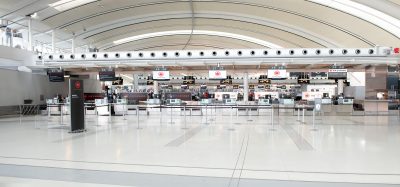Transforming Airfield Lighting: The research into LED technology
- Like
- Digg
- Del
- Tumblr
- VKontakte
- Buffer
- Love This
- Odnoklassniki
- Meneame
- Blogger
- Amazon
- Yahoo Mail
- Gmail
- AOL
- Newsvine
- HackerNews
- Evernote
- MySpace
- Mail.ru
- Viadeo
- Line
- Comments
- Yummly
- SMS
- Viber
- Telegram
- Subscribe
- Skype
- Facebook Messenger
- Kakao
- LiveJournal
- Yammer
- Edgar
- Fintel
- Mix
- Instapaper
- Copy Link
Posted: 1 October 2010 | Jennifer Taylor, Lighting Research Center, Rensselaer Polytechnic Institute, Troy, N.Y. | No comments yet
Advanced, energy-efficient lighting is one key element of global research to reduce energy consumption and carbon emissions. In just the last decade, the light-emitting diode (LED) has progressed from a small indicator light to a complete lighting system able to illuminate spaces such as an entire parking lot. LEDs promise much to be excited about: less energy consumption, reduced lifetime costs and maintenance, rugged design, “tunability”, and non-toxicity. However, implementing LEDs is not as simple as unscrewing one light bulb and replacing it with another.
Advanced, energy-efficient lighting is one key element of global research to reduce energy consumption and carbon emissions. In just the last decade, the light-emitting diode (LED) has progressed from a small indicator light to a complete lighting system able to illuminate spaces such as an entire parking lot. LEDs promise much to be excited about: less energy consumption, reduced lifetime costs and maintenance, rugged design, “tunability”, and non-toxicity. However, implementing LEDs is not as simple as unscrewing one light bulb and replacing it with another.
LEDs – semiconductors that emit photons – are an inherently different light source than traditional incandescent, fluorescent and highintensity discharge lamps, which consist of a filament and gasses inside a glass envelope. A complex understanding of the LED’s benefits, drawbacks, perception differences, and system integration techniques is required in order to create a successful LED lighting installation.
Aviation is one industry that has taken significant steps to evaluate the potential of LED lighting. In particular, the FAA is interested in the potential of LEDs to replace existing incandescent lighting on U.S. airfields. Airfields pose a unique challenge for LED lighting. Generally, airfield lighting requirements are more stringent than those for residential, commercial or outdoor lighting. These requirements are necessary to ensure safety, visibility, and the longevity and weatherability of the lighting systems installed. In its evaluations of LED lighting, the FAA has been interested primarily in 1) the system performance of LEDs as compared with incandescent lighting systems, and 2) in the perception of LED lighting and how LEDs might provide better (or worse) visual cues and safety to pilots.
In 2005, the Lighting Research Center (LRC) at Rensselaer Polytechnic Institute was selected by the FAA to join its Centers of Excellence programme in the field of airport technology. The LRC was charged with applying its expertise in LED lighting, vision science, and human factors research to provide new lighting solutions that benefit the aviation industry. In the last five years, the LRC has explored a number of performance and visibility issues related to LED airfield lighting systems. These research findings are now leading to reviews of, and changes to, current airfield lighting regulations, which were written originally on the basis of incandescent lamp performance.
System Performance: How Is An LED Not Like An Incandescent Lamp?
One of the first studies undertaken was the use of LEDs for blue taxiway lights. One of the key benefits of coloured LEDs is that they are much more efficient than filtered incandescent lamps, which lose a significant amount of light output when a coloured filter is placed in front of the lamp. In a traditional taxiway light fixture, a blue borosilicate glass dome covers the incandescent lamp, resulting in a fixture efficiency of less than 1%. According to U.S. Department of Energy estimates, 50 million kilowatt hours of electricity could be saved each year in the United States if all taxiway luminaires were converted to LEDs. However, unlike incandescent lamps, LEDs do not radiate enough heat to melt ice and snow from the light fixture’s dome-shaped optics, a must in cold climates. To meet FAA regulations for weatherability, some manufacturers of LED taxiway fixtures incorporate electric heaters that, when switched on, practically negate the energy-savings benefit of converting to LED sources.
The LRC explored new fixture designs and methods of transferring heat from the LED to the optics for the purpose of minimising snow and ice buildup, without needing heaters. A novel prototype design was produced that used several blue LEDs distributed around an aluminum heat sink (a device to conduct heat away from the LED). This design reduced the size of the optics surface as well as the path length for the heat to travel from the LED to the optics. Laboratory tests at room temperature showed that the prototype met FAA photometry requirements. At 10 watts, the prototype fixture was projected to produce enough heat to melt ice and snow at –40°C.
Another way in which LEDs do not perform like incandescent lamps, and one that is critical to pilots, is in terms of “brightness” perception. The word brightness is used in quotes here because it is a subjective term that, while commonly applied to lighting (boy, that light is really bright!), does not actually have a method by which to be measured. Colour saturation increases the perception of brightness, and certain wavelengths in the blue to greenish-yellow range are known to be more effective to the visual system. Generally, LED signal lights have narrower spectral distributions than incandescent (filtered and unfiltered) signals, resulting in more saturated colours.
To account for increases in brightness perception, the LRC conducted a study to develop a set of “brightness correction factors” for white, green, and blue signal lights. In this study, brightness-to-luminous intensity (B/L) ratio values were identified for each of the three colours of LED signals (and in different LED colour bins) relative to incandescent signals of the same nominal colour. In a dark laboratory, subjects viewed pairs of signal lights, one LED and one incandescent. Subjects judged which appeared brighter while adjusting the intensity of the LED. Additional experiments determined other factors affecting B/L values, including arrays of signal lights (rather than single lights), dim (rather than dark) conditions, and simulated fog conditions. Generally, subjects judged the LED signals as brighter than the incandescent signals of the same nominal colour. Only the simulated fog had reliable effects on B/L values, reducing the relative brightness differences between LED and incandescent signal lights. These results were used to develop a general model with which signal lights of any chromaticity within the FAA colour boundaries could be assessed for their B/L characteristics.
Colour Requirements: Making the Case for Lighting Chromaticity Based on Human Visual Performance
While brightness correction factors can help adjust the intensity levels of different colours of LED signal lights, the question remains whether the colour hues themselves are appropriate for airfield signals. A pilot’s recognition of an aviation signal’s colour from a distance depends on its chromaticity, the layout of the lights on the airfield, and the chromaticity of other lights and signals in the field of view. Current chromaticity standards for “aviation white” were established in the 1960s and are based on the typical chromaticities of incandescent light sources, which tend to be a “warm” yellowishwhite (corresponding to a lower correlated colour temperature [CCT]). The existing chromaticity boundary (a designated area in chromaticity space) for aviation white does not allow for certain colour bins of white LEDs, especially those of a “cool” bluish-white hue (corresponding to a higher CCT). These higher CCT LEDs are typically more efficient than warm-white LEDs. Because only a small subset of commercially available white LEDs can meet the current chromaticity requirements for aviation white, it is difficult to adopt white LEDs for airfield signalling.
The LRC conducted a human factors investigation of the chromaticity boundaries that people perceive as white and recommended new aviation white boundaries that are independent of the colour limitations of incandescent sources. Researchers presented colour samples from a large area in and around the current aviation white boundary region to develop a “region of interest,” and these results were used to predict patterns of chromaticity acceptance as “white.” In the study’s first phase, subjects viewed precise colour samples but their context was not representative of what a pilot would see. In the second phase, researchers investigated the acceptability of the white chromaticities identified earlier using LEDs and coloured filters to produce the samples. The samples were arranged along a simulated airport runway built in a laboratory. The runway, airfield and subject’s angle of view were scaled so that the size, orientation, and intensity of the samples were representative of how a pilot would observe them.
The results indicated that the current colour boundary of aviation white extends too far toward the “yellow” region while the “blue” boundary may be too conservative. Based on these results as well as established literature and recommendations on light source colour, the LRC recommended moving the boundary and accepting all the white LED chromaticities currently allowable for LED lighting systems. However, these new colour boundaries still need to be tested and validated in the field before adoption. Standards-setting bodies are now reviewing existing specifications for signal chromaticity on the basis of this study.
“Tuning” LEDs for Visual Performance
Runway guard lights (RGLs) are another lighting application where LEDs are making headway. One advantage of LED technology is the ability to “tune” LEDs to make the light output more or less noticeable to the human eye. In a human factors study, LED-based RGLs were “tuned” by manipulating frequencies (flash rates) and ontimes to determine first the relative luminous intensity required by RGLs using all lighting technologies, and second to increase the conspicuity of LED-based RGLs over that of incandescent-based RGLs. Reaction times and conspicuity data were collected from subjects in a laboratory environment that simulated daytime, night-time and foggy daytime conditions. For the three environmental conditions, the LRC concluded that the current minimum intensity requirements for incandescent-based RGLs are sufficiently noticeable to pilots and that these minimum levels for incandescent RGLs should not decrease. Researchers then went on to test a range of LED-based RGL frequencies and on-times. Based on the findings, the most effective combinations of frequency and on-time for best conspicuity and fastest reaction time were determined. When applying these ideal combinations, the average minimum luminous intensity of LED-based RGLs could be reduced by approximately 60% from the current recommended values, providing an opportunity for energy savings.
Adoption of LED Airfield Lighting Is Certain
These findings and research in progress are leading to a better understanding of how to best implement LED lighting for airfields in order to provide safety, conspicuity, weatherability and energy savings. Even remote airfields can benefit from LEDs. The LRC has studied night-time vision and the effects of LED colour, intensity, flash pattern, viewing angle, and spatial arrangement to make night-time landings in rural areas safer. Studies of solar-powered airfield lights have led to a better understanding of the factors that affect the performance of standalone photovoltaic LED lighting systems. Work still remains, however, particularly in the fields of LED chip and packaging technology, to make LEDs more efficient and to bring down their initial purchase cost. These will come in just a matter of time because research in these areas is advancing rapidly.
But in order for airports and airfields to maximally benefit from LED technology, changes to the electrical infrastructure of airfields must be considered. These changes would include a major overhaul of the design of electrical circuits for airfield lighting. Presently, electrical circuits for airfields are optimised for incandescent systems. While LED lighting can work off this current design, more energy savings would be realised from a new electrical circuit infrastructure designed especially for LEDs. Under the direction of Donald Gallagher and the team at the FAA’s Visual Guidance Programme, industry and academia have begun analysing the existing electrical infrastructure at U.S. airfields in order to propose new electrical systems that will make it easier for LED lighting to be integrated for a variety of airfield lighting applications.
For more information about airfield lighting research, visit the LRC’s aviation research page: www.lrc.rpi.edu/researchAreas/aviation.asp
About the Author
Jennifer Taylor
Jennifer Taylor, MSc, is a senior communications specialist for the Lighting Research Center at Rensselaer Polytechnic Institute, Troy, New York, since 2003. She works primarily in the field of solidstate lighting and LEDs, and has worked with the LRC’s solid-state lighting team to produce lighting test methods, application guidelines, journal articles, research summaries, and other publications about LED lighting.
















